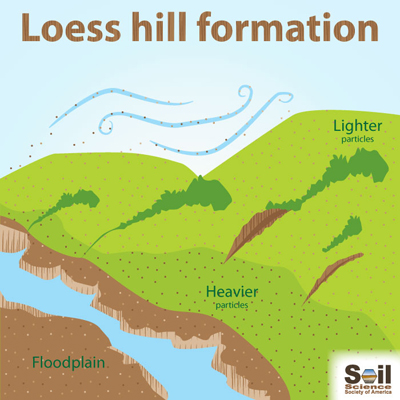Soil Science Society of America
5585 Guilford Road • Madison, WI 53711-5801 • 608-273-8080 • Fax 608-273-2021
www.soils.org
Twitter | Facebook
NEWS RELEASE
Contact: Hanna Jeske, Associate Director of Marketing and Brand Strategy, 608-268-3972, hjeske@sciencesocieties.org
Why do the loess hills of Iowa need to be farmed in terraces?
June 18, 2018 – Iowa, known for its farms, also claims fame to a dramatic, rolling landscape known as loess hills. The Soil Science Society of America (SSSA) June 15 Soils Matter blog explains what formed this feature, and why its soil requires special care.
 Loess (from the German word “löss,” which translates as “loose”) hills are formed by finely-textured silt that has been carried by the wind. About 10% of the Earth’s surface has this feature—but Iowa’s deposits are particularly deep, and famously productive in agricultural uses.
Loess (from the German word “löss,” which translates as “loose”) hills are formed by finely-textured silt that has been carried by the wind. About 10% of the Earth’s surface has this feature—but Iowa’s deposits are particularly deep, and famously productive in agricultural uses.
Blogger Mary Tiedeman, an Iowa-raised soil scientist at Florida International University, explains. “The high silt content of loess-derived soils allows water to drain freely through the profile, ensuring that plant roots receive constant supplies of oxygen and do not become water logged. Water that does stay within the soil is held loosely so plant roots can access it with minimal effort. The texture of silt also enables roots to colonize soil profiles without restriction.”
This loose structure, however, comes with a downfall: erosion. “To use loess soils sustainably, managers must control wind and water erosion,” Tiedeman says. In agriculture, strategies include the use of cover crops, intercropping, terraces, and limited tilling. “The steepest areas may be better left undeveloped, or used as grazing land, recreation, and/or conservation land.”
“Loess soils also comprise a significant percentage of the world’s most arable land. If used sustainably, these soils will continue to support life in the ground and across the planet for generations to come,” Tiedeman concludes.
To read the entire blog post, visit https://wp.me/p3Rg6r-nV.
Follow SSSA on Facebook at https://www.facebook.com/SSSA.soils, Twitter at SSSA_Soils. SSSA has soils information on www.soils.org/discover-soils, for teachers at www.soils4teachers.org, and for students through 12th grade, www.soils4kids.org.